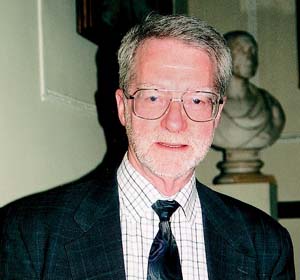| 2004 |

|
YEAR BOOK |
Royal Irish Academy
|
New Science Members of the Royal Irish Academy
|

At their election, Dr Michael Ryan, President of the Royal Irish Academy, said 'Excellence is the only benchmark of the knowledge society. Those elected as Members of the Royal Irish Academy have raised the benchmark of excellence in their respective fields internationally, and bring honour on themselves and Ireland by their achievements'.
The new science MRIAs are:
Professor Derek Boyd (Queen's University, Belfast), is a world authority on the use of micro-organisms to effect transformations of organic molecules into products that are often difficult or impossible to obtain by conventional chemical routes.
Professor Emer Colleran (NUI, Galway), is a leading authority in environmental microbiology. Her research interests include the microbiology of anaerobic digestion and its applications to the treatment of domestic, agricultural and industrial wastes and wastewaters.
Dr Roger Downer (University of Limerick), has an international reputation as a zoologist and has made seminal contributions that have significantly shaped and influenced our understanding of the physiology and biochemistry of insects.
Professor Michael Hayes (University of Limerick), has an outstanding research record for his work on the organic and inorganic constituents of soil. He is a world leading authority in both basic and applied humic substances research.
Professor Celia Holland (Trinity College, Dublin), has a well-deserved international reputation as a parasitologist. She has made original and significant contributions to our knowledge of parasites, particularly those that impact on human health.
Professor Eugene Kennedy (Dublin City University), is generally considered to be the most eminent experimental atomic physicist in Ireland and is internationally highly regarded. His work in DCU has concentrated on measurements using the dual laser plasma technique which he pioneered.
Professor Michael Peter Kennedy (University College, Cork), is a world leader in the field of nonlinear dynamics and chaos. His publications on chaos in electronic circuits have been incorporated into teaching and research programmes in electrical engineering world-wide.
Professor Marshall McCabe (University of Ulster), is internationally renowned as a top glacial geologist and has been at the forefront of glacial sedimentology, ice sheet�climate interactions, and sea-level history related to the last deglaciation of Ireland.
Professor Luke O'Neill (Trinity College, Dublin), is one of the foremost researchers in the area of the molecular basis for inflammation, as occurs in such diseases as rheumatoid arthritis.
Professor Gerry O'Sullivan (University College, Dublin), has an excellent international reputation as a scientist and a leader of research in the field of spectroscopy of high temperature laser produced plasmas.
Professor Ian Robertson (Trinity College, Dublin), is one of the world's leading authorities on brain rehabilitation. His best-selling popular science book, Mind Sculpture, has been translated into ten languages, including Japanese.

New Science Secretary
In March 2004, the Academy elected Professor David Fegan as Science Secretary. Professor Fegan has been a Research Astrophysicist at University College Dublin since the mid-1960s. His early research work was mainly in Cosmic Ray studies, developing radio and optical techniques to detect high energy cosmic rays using ground-based systems. Subsequently, he was involved in astrophysical searches for magnetic monopoles, tachyons, quark matter and anti-matter. He is a founder member of both the Whipple and VERITAS international collaborations in High Energy Astrophysics. With a small number of collaborators, he has pioneered the Imaging Atmospheric Cerenkov Technique which has established a new high-energy window on the Universe, at TeV energies, effectively discovering the first Galactic and Extra-galactic sources of extremely high-energy Gamma Radiation. Professor Fegan has published over 300 papers in Astrophysics. In the mid 1990s, Professor Fegan was a founder member of the Irish Research Scientists' Association (IRSA) and a member of the Science Technology and Innovation Advisory Council (STIAC). He has also served on the National Research Support Fund Board (NRSFB) from 1995 to 1998.
Contact: Pauric Dempsey,
Royal Irish Academy, 19 Dawson Street, Dublin 2; Tel: 01-6762570;
E-Mail: [email protected] ;Web: www.ria.ie